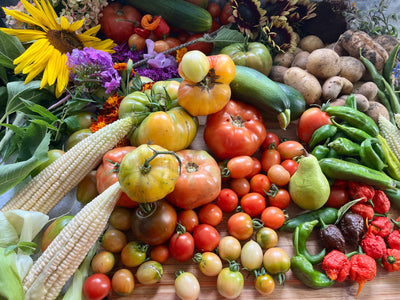Permaculture gardening is an innovative, sustainable approach to growing food that works with nature rather than against it. It’s not just a gardening method; it’s a way of creating a self-sufficient ecosystem where everything thrives in harmony. In this article, we'll dive into the essentials of permaculture, how to create your own permaculture garden, and why it's an incredible tool for both gardeners and the planet.
What is Permaculture?
Permaculture, short for "permanent agriculture" or "permanent culture," is a design philosophy that seeks to create sustainable environments. Rooted in principles of ecology, it promotes natural processes to cultivate food, shelter, and energy. The goal is to mimic natural ecosystems, ensuring that all elements within the system benefit one another.
Rather than relying on artificial inputs like chemical fertilizers or pesticides, permaculture focuses on building resilient systems that regenerate the land, reduce waste, and conserve energy. It's a holistic approach that addresses the needs of both humans and nature.
Why Choose Permaculture Gardening?
Permaculture gardening has become increasingly popular because it helps you:
- Grow food naturally : No synthetic chemicals or genetically modified seeds.
- Save time and effort : Work with natural systems, so the garden requires less maintenance.
- Reduce environmental impact : Improve biodiversity and minimize waste.
- Conserve resources : Lower water usage and reliance on non-renewable resources.
If you're interested in growing your own food, creating a permaculture garden might just be the best decision you'll ever make!
Key Principles of Permaculture
Permaculture is based on a few key principles that guide the design of a self-sufficient ecosystem. Here are some foundational ideas to keep in mind:
1. Observe and Interact
The first step in any permaculture design is to observe the natural landscape and understand its unique conditions. Where does the sun hit? How does water flow? What wildlife is present? Interacting with the land allows you to design a garden that thrives based on the natural features of your space.
2. Catch and Store Energy
Permaculture gardens make the most of natural resources. This could mean using rain barrels to catch and store water, planting trees to provide shade and regulate temperature, or creating compost heaps to recycle organic matter. Each part of your garden should contribute to capturing and storing energy, reducing your reliance on outside inputs.
3. Obtain a Yield
The goal of a permaculture garden is to produce food, shelter, and other resources in a sustainable way. While it takes time to establish a permaculture system, once it’s up and running, it should provide a reliable yield of fruits, vegetables, herbs, and more with minimal input.
4. Use Renewable Resources
Instead of synthetic fertilizers, permaculture gardens use natural compost, mulch, and organic matter. You'll also plant perennials that keep producing year after year, cutting down on the need to replant annually. This reduces the energy required to maintain the garden and promotes biodiversity.

5. Integrate, Don't Segregate
In permaculture gardening, different elements of the system work together. For example, chickens can help control pests, and compost bins return nutrients to the soil. This interconnectivity creates a system that is self-sustaining and efficient.
How to Start Your Own Permaculture Garden
Creating your own permaculture garden is an exciting and rewarding journey. Here are the steps to get you started on the path to self-sufficiency.
Step 1: Start with a Plan
Before you get your hands dirty, it's important to have a plan. Begin by assessing your space and taking notes on the natural elements present. Identify key features like sunlight, wind patterns, and water flow. Knowing this will help you design a garden that works in harmony with your landscape.
Step 2: Create Zones
Permaculture gardens are often divided into zones based on how frequently different areas are accessed. Here's a breakdown:
- Zone 1: Close to your home and reserved for daily-use plants like herbs and vegetables.
- Zone 2: Further from the home, where you can grow fruit trees or keep a chicken coop.
- Zone 3: The area for less intensive cultivation, like a food forest or orchard.
- Zone 4: A semi-wild area that supports biodiversity and provides resources like firewood.
- Zone 5: A completely wild area left to nature. It provides inspiration and attracts beneficial wildlife.
Step 3: Build Soil Health
Healthy soil is the foundation of any permaculture garden. Use organic compost, mulch, and cover crops to build nutrient-rich soil. This creates a thriving environment for your plants, reduces the need for fertilizers, and helps the soil retain moisture.
Consider starting a composting system to recycle kitchen scraps, yard waste, and other organic materials. Over time, this compost will break down into rich, fertile soil that you can use to nourish your plants.
Step 4: Choose Perennials and Companion Plants
Permaculture gardens emphasize the use of perennial plants, which return year after year. Perennials like fruit trees, berry bushes, and herbs are low-maintenance and provide a continuous yield without replanting. Invest in Seed Armory's selection of organic, non-GMO and heirloom seeds to start your survival garden off right.
Companion planting is another key concept in permaculture. Certain plants, when grown together, support each other’s growth. For example, planting beans alongside corn helps replenish nitrogen in the soil, while marigolds can repel pests from your vegetable beds.
Step 5: Harvest and Store Water
Efficient water use is critical in permaculture gardening. Install rainwater harvesting systems like rain barrels to collect water for irrigation. You can also use swales (ditches on a contour) to capture and direct water to plants naturally.
Drip irrigation and mulching are other great ways to conserve water and keep the soil moist, ensuring your plants get what they need even in dry spells.

Step 6: Integrate Animals (Optional)
In permaculture, animals can play an important role in maintaining the ecosystem. Chickens, for example, can help control pests and fertilize the soil with their manure. Bees are essential for pollination, while goats can manage weeds.
Even if you don’t want to raise livestock, creating a garden that attracts beneficial wildlife, such as birds and bees, will improve pollination and pest control.
Long-Term Care and Maintenance
One of the best aspects of permaculture gardening is that, once established, it requires less maintenance than traditional gardening. Focus on:
- Mulching : Mulch helps retain moisture, suppresses weeds, and improves soil health as it decomposes.
- Pruning and Harvesting : Keep your plants healthy and productive by pruning and harvesting regularly.
- Adding Organic Matter : Periodically adding compost, leaves, and other organic matter will maintain soil health and fertility.
Permaculture gardens are designed to evolve. Each year, observe how your garden performs and make small adjustments to improve its efficiency and yield.
Benefits of a Permaculture Garden
A permaculture garden offers more than just food; it creates a self-sufficient ecosystem that works with nature. Here are some key benefits:
- Minimal maintenance : Once your system is established, it requires little upkeep.
- Biodiversity : Permaculture promotes a diverse range of plants and animals, which improves resilience.
- Reduced waste : Composting, water harvesting, and natural pest control reduce the need for outside resources.
- Food security : Grow your own food sustainably and become more self-reliant.
- Environmental health : Help restore soil health, reduce carbon emissions, and conserve water.
Why Permaculture Gardening is the Key to a Sustainable, Self-Sufficient Future
Permaculture gardening is a practical and rewarding way to create a self-sufficient ecosystem that provides for both you and the planet. By following nature’s lead, you can grow abundant food, conserve resources, and reduce your environmental impact. Whether you’re a seasoned gardener or just getting started, incorporating permaculture principles into your garden will lead to long-lasting benefits.
Ready to start your permaculture journey? Begin by observing your landscape, designing with nature in mind, and planting a garden that will flourish for years to come.











